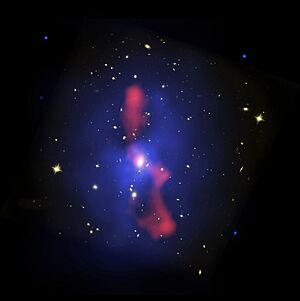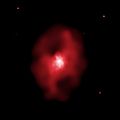MS 0735.6+7421 facts for kids
Quick facts for kids MS 0735.6+7421 |
|
|---|---|
| MS 0735.jpg | |
| Observation data (Epoch J2000) | |
| Right ascension | 07h 41m 50.2s |
| Declination | +74° 14′ 51″ |
MS 0735.6+7421 is a giant group of galaxies. It is located in the direction of the constellation Camelopardalis. This amazing cluster is about 2.6 billion light-years away from Earth. It is home to one of the most massive black holes ever found in the universe.
This black hole also caused the most powerful explosion. This huge burst of energy was discovered since the Big Bang.
About MS 0735.6+7421
A galaxy cluster is a very large group of galaxies. These galaxies are all held together by gravity. MS 0735.6+7421 is one such cluster. It is incredibly far away from us. A light-year is the distance light travels in one year. So, 2.6 billion light-years is a truly vast distance!
A Giant Black Hole
At the center of MS 0735.6+7421 is a supermassive black hole. A black hole is a place in space where gravity pulls so much that even light cannot escape. This black hole is one of the biggest known. It has a mass equal to billions of suns.
A Huge Eruption
This giant black hole caused an enormous eruption. This event was like a cosmic explosion. It sent out huge amounts of energy. Scientists call this an "active galactic nucleus eruption." It is the most powerful one ever seen. This eruption created two giant cavities. These are like huge bubbles in the hot gas around the cluster. Each cavity is about 600,000 light-years wide.
The eruption released a massive amount of energy. It was more energy than hundreds of millions of supernovas. A supernova is a powerful star explosion. This eruption is a big discovery for astronomers. It helps us understand how black holes affect their surroundings.
Images for kids
-
Chandra image of the hot X-ray emitting gas that pervades the galaxy cluster MS 0735.6+7421 in the constellation Camelopardalis. Two vast cavities - each 600,000 lyrs in diameter appear on opposite sides of a large galaxy at the center of the cluster. These cavities are filled with a two-sided, elongated, magnetized bubble of extremely high-energy electrons that emit radio waves. Image is 4.2 arcmin per side. RA 07h 41m 50.20s Dec +74° 14' 51.00". Observation date: November 30, 2003. Credit: NASA/CXC/Ohio U./B.McNamara.
See also
 In Spanish: MS 0735 para niños
In Spanish: MS 0735 para niños



